The Studies on Chitosan for Sustainable Development: A Bibliometric Analysis
Abstract
1. Introduction
2. Methodology
3. Results
3.1. Document Type and Source Type
3.2. Annual Publication
3.3. Subject Area
3.4. Country Contribution
3.5. Source Title
3.6. Highly Cited Documents
3.7. Keyword Analysis
3.8. Citation Metric
4. Conclusions
Author Contributions
Funding
Data Availability Statement
Acknowledgments
Conflicts of Interest
References
- Aranaz, I.; Alcántara, A.R.; Civera, M.C.; Arias, C.; Elorza, B.; Caballero, A.H.; Acosta, N. Chitosan: An overview of its properties and applications. Polymers 2021, 13, 3256. [Google Scholar] [CrossRef] [PubMed]
- Salgado-Cruz, M.d.l.P.; Salgado-Cruz, J.; García-Hernández, A.B.; Calderón-Domínguez, G.; Gómez-Viquez, H.; Oliver-Espinoza, R.; Fernández-Martínez, M.C.; Yáñez-Fernández, J. Chitosan as a coating for biocontrol in postharvest products: A bibliometric review. Membranes 2021, 11, 421. [Google Scholar] [CrossRef] [PubMed]
- Danarto, Y.C.; Distantina, S. Optimizing deacetylation process for chitosan production from green mussel (Perna viridis) shell. AIP Conf. Proc. 2016, 1710, 030028. [Google Scholar]
- Kou, S.G.; Peters, L.M.; Mucalo, M.R. Chitosan: A review of sources and preparation methods. Int. J. Biol. Macromol. 2021, 169, 85–94. [Google Scholar] [CrossRef]
- Valdez, M.I.; Garcia, J.; Ubeda-Manzanaro, M.; Martinez, A.; Rodrigo, D. Insect chitosan as a natural antimicrobial against vegetative cells of Bacillus cereus in a cooked rice matrix. Food Microbiol. 2022, 107, 104077. [Google Scholar] [CrossRef]
- Ismail, A.S.; Darwish, M.S.A.; Ismail, E.A. Synthesis and characterization of hydrophilic chitosan-polyvinyl acetate blends and their sorption performance in binary methanol–water mixture. Egypt. J. Pet. 2017, 26, 17–22. [Google Scholar] [CrossRef]
- Cohen, E.; Poverenov, E. Hydrophilic chitosan derivatives: Synthesis and applications. Chem. Eur. J. 2022, 28, e202202156. [Google Scholar] [CrossRef]
- Antunes, B.P.; Moreira, A.F.; Gaspar, V.M.; Correia, I.J. Chitosan/arginine–chitosan polymer blends for assembly of nanofibrous membranes for wound regeneration. Carbohydr. Polym. 2015, 130, 104–112. [Google Scholar] [CrossRef]
- Torkaman, S.; Rahmani, H.; Ashori, A.; Najafi, S.H.M. Modification of chitosan using amino acids for wound healing purposes: A review. Carbohydr. Polym. 2021, 258, 117675. [Google Scholar] [CrossRef]
- Cui, J.; Ji, X.; Mi, Y.; Miao, Q.; Dong, F.; Tan, W.; Guo, Z. Antimicrobial and antioxidant activities of N-2-Hydroxypropyltrimethyl ammonium chitosan derivatives bearing amino acid Schiff bases. Mar. Drugs 2022, 20, 86. [Google Scholar] [CrossRef]
- Min, T.; Zhu, Z.; Sun, X.; Yuan, Z.; Zha, J.; Wen, Y. Highly efficient antifogging and antibacterial food packaging film fabricated by novel quaternary ammonium chitosan composite. Food Chem. 2020, 308, 125682. [Google Scholar] [CrossRef] [PubMed]
- Cohen, Y.; Mwangi, E.; Tish, N.; Xu, J.; Vaze, N.D.; Klingbell, T.; Fallik, E.; Luo, Y.; Demokritou, P.; Rodov, V.; et al. Quaternized chitosan as a biopolymer sanitizer for leafy vegetables: Synthesis, characteristics, and traditional vs. dry nano-aerosol applications. Food Chem. 2022, 378, 132056. [Google Scholar] [CrossRef] [PubMed]
- Gaspar, V.M.; Costa, E.C.; Queiroz, J.A.; Pichon, C.; Sousa, F.; Correia, I.J. Folate-targeted multifunctional amino acid-chitosan nanoparticles for improved cancer therapy. Pharm. Res. 2015, 32, 562–577. [Google Scholar] [CrossRef]
- Song, J.; Liu, J.; Zhao, W.; Chen, Y.; Xiao, H.; Shi, X.; Liu, Y.; Chen, X. Quaternized chitosan/PVA aerogels for reversible CO2 capture from ambient air. Ind. Eng. Chem. Res. 2018, 57, 4941–4948. [Google Scholar] [CrossRef]
- Cui, H.; Wu, N.; Ma, X.; Niu, F. Superior intrinsic flame-retardant phosphorylated chitosan aerogel as fully sustainable thermal insulation bio-based material. Polym. Degrad. Stab. 2023, 207, 110213. [Google Scholar] [CrossRef]
- Malucelli, G. Flame-retardant systems based on chitosan and its derivatives: State of the art and perspectives. Molecules 2020, 25, 4046. [Google Scholar] [CrossRef] [PubMed]
- Chaiwong, N.; Leelapornpisid, P.; Jantanasakulwong, K.; Rachtanapun, P.; Seesuriyachan, P.; Sakdatorn, V.; Leksawasdi, N.; Phimolsiripol, Y. Antioxidant and moisturizing properties of carboxymethyl chitosan with different molecular weights. Polymer 2020, 12, 1445. [Google Scholar] [CrossRef] [PubMed]
- Nilsen-Nygaard, J.; Strand, S.P.; Vårum, K.M.; Draget, K.I.; Nordgård, C.T. Chitosan: Gels and interfacial properties. Polymers 2015, 7, 552–579. [Google Scholar] [CrossRef]
- Adewunmi, A.A.; Mahboob, A.; Kamal, M.S.; Sultan, A. Pickering emulsions stabilized by chitosan/natural acacia gum biopolymers: Effects of pH and salt concentrations. Polymers 2022, 14, 5270. [Google Scholar] [CrossRef]
- Adamuchio-Oliveira, L.G.; Mazaro, S.M.; Mógor, G.; Sant’Anna-Santos, B.F.; Mógor, Á.F. Chitosan associated with chelated copper applied on tomatoes: Enzymatic and anatomical changes related to plant defense responses. Sci. Hortic. 2020, 271, 109431. [Google Scholar] [CrossRef]
- Jogaiah, S.; Satapute, P.; De Britto, S.; Konappa, N.; Udayashankar, A.C. Exogenous priming of chitosan induces upregulation of phytohormones and resistance against cucumber powdery mildew disease is correlated with localized biosynthesis of defense enzymes. Int. J. Biol. Macromol. 2020, 162, 1825–1838. [Google Scholar] [CrossRef]
- Tang, T.; Cao, S.; Xi, C.; Chen, Z. Multifunctional magnetic chitosan-graphene oxide-ionic liquid ternary nanohybrid: An efficient adsorbent of alkaloids. Carbohydr. Polym. 2021, 255, 117338. [Google Scholar] [CrossRef]
- Jiang, Q.; Han, Z.; Li, W.; Ji, T.; Yuan, Y.; Zhang, J.; Zhao, C.; Cheng, Z.; Wang, S. Adsorption properties of heavy metals and antibiotics by chitosan from larvae and adult Trypoxylus dichotomus. Carbohydr. Polym. 2022, 276, 118735. [Google Scholar] [CrossRef]
- Tang, S.; Yang, J.; Lin, L.; Peng, K.; Chen, Y.; Jin, S.; Yao, W. Construction of physically crosslinked chitosan/sodium alginate/calcium ion double-network hydrogel and its application to heavy metal ions removal. Chem. Eng. J. 2020, 393, 124728. [Google Scholar] [CrossRef]
- Nematidil, N.; Sadeghi, M.; Nezami, S.; Sadeghi, H. Synthesis and characterization of Schiff-base based chitosan-gglutaraldehyde/NaMMTNPs-APTES for removal Pb2+ and Hg2+ ions. Carbohydr. Polym. 2019, 222, 114971. [Google Scholar] [CrossRef] [PubMed]
- Yang, L.; Luo, X.; Yan, L.; Zhou, Y.; Yu, S.; Ju, H.; Wang, Y.; Zhang, L. Efficient selective adsorption of uranium using a novel eco-friendly chitosan-grafted adenosine 5’-monophosphate foam. Carbohydr. Polym. 2022, 285, 119157. [Google Scholar] [CrossRef]
- Song, Z.; Li, G.; Guan, F.; Liu, W. Application of chitin/chitosan and their derivatives in the papermaking industry. Polymers 2018, 10, 389. [Google Scholar] [CrossRef]
- Pellis, A.; Guebitz, G.M.; Nyanhongo, G.S. Chitosan: Sources, processing and modification techniques. Gels 2022, 8, 393. [Google Scholar] [CrossRef] [PubMed]
- Yang, Z.; Miao, H.; Rui, Z.; Ji, H. Enhanced formaldehyde removal from air using fully biodegradable chitosan grafted β-cyclodextrin absorbent with weak chemical interaction. Polymers 2019, 11, 276. [Google Scholar] [CrossRef]
- Kumar, S.; Silva, J.A.E.; Wani, M.Y.; Gil, J.M.; Sobral, A.J.F.N. Carbon dioxide capture and conversion by an environmentally friendly chitosan based meso-tetrakis(4-sulfonatophenyl) porphyrin. Carbohydr. Polym. 2017, 175, 575–583. [Google Scholar] [CrossRef] [PubMed]
- Irimia-Vladu, M. “Green” electronics: Biodegradable and biocompatible materials and devices for sustainable future. Chem. Soc. Rev. 2014, 43, 588. [Google Scholar] [CrossRef]
- Miao, J.; Liu, H.; Li, Y.; Zhang, X. Biodegradable transparent substrate based on edible starch-chitosan embedded with nature-inspired three-dimensionally interconnected conductive nanocomposites for wearable green electronics. ACS Appl. Mater. Interfaces 2018, 10, 23037–23047. [Google Scholar] [CrossRef]
- Jin, Y.; Sun, Y.; Wang, K.; Chen, Y.; Liang, Z.; Xu, Y.; Xiao, F. Long-term stable silver nanowire transparent composite as bottom electrode for perovskite solar cells. Nano Res. 2018, 11, 1998–2011. [Google Scholar] [CrossRef]
- Zhang, K.; Xu, R.; Ge, W.; Qi, M.; Zhang, G.; Xu, Q.; Huang, F.; Cao, Y.; Wang, X. Electrostatically self-assembled chitosan derivatives working as efficient cathode interlayers for organic solar cells. Nano Energy 2017, 34, 164–171. [Google Scholar] [CrossRef]
- Du, B.; Hu, S.; Singh, R.; Tsai, T.; Lin, C.; Ko, F. Eco-friendly and biodegradable biopolymer chitosan/Y2O3 composite materials in flexible organic thin-film transistors. Materials 2017, 10, 1026. [Google Scholar] [CrossRef] [PubMed]
- Maliki, S.; Sharma, G.; Kumar, A.; Moral-Zamorano, M.; Moradi, O.; Baselga, J.; Stadler, F.J.; García-Peñas, A. Chitosan as a tool for sustainable development: A mini review. Polymers 2022, 14, 1475. [Google Scholar] [CrossRef] [PubMed]
- Hameed, A.Z.; Raj, S.A.; Kandasamy, J.; Baghdadi, M.A.; Shahzad, M.A. Chitosan: A sustainable material for multifarious applications. Polymers 2022, 14, 2335. [Google Scholar] [CrossRef]
- Kostag, M.; Seoud, O.A.E. Sustainable biomaterials based on cellulose, chitin and chitosan composites—A review. Carbohydr. Polym. Technol. Appl. 2021, 2, 100079. [Google Scholar] [CrossRef]
- Klongthong, W.; Muangsin, V.; Gowanit, C.; Muangsin, N. Chitosan biomedical applications for the treatment of viral diseases: A data mining model using bibliometric predictive intelligence. J. Chem. 2020, 2020, 6612034. [Google Scholar] [CrossRef]
- Martău, G.A.; Mihai, M.; Vodnar, D.C. The use of chitosan, alginate, and pectin in the biomedical and food sector—Biocompatibility, bioadhesiveness, and biodegradability. Polymers 2019, 11, 1837. [Google Scholar] [CrossRef]
- Ranjan, N. Chitosan with PVC polymer for biomedical applications: A bibliometric analysis. Mater. Today Proc. 2023, in press. [Google Scholar] [CrossRef]
- Crini, G. Non-conventional low-cost adsorbents for dye removal: A review. Bioresour. Technol. 2006, 97, 1061–1085. [Google Scholar] [CrossRef] [PubMed]
- Boateng, J.S.; Matthews, K.H.; Stevens, H.N.E.; Eccleston, G.M. Wound healing dressings and drug delivery systems: A review. J. Pharm. Sci. 2008, 97, 2892–2923. [Google Scholar] [CrossRef] [PubMed]
- Chiari, W.; Damayanti, R.; Harapan, H.; Puspita, K.; Saiful, S.; Rahmi, R.; Rizki, D.R.; Iqhrammullah, M. Trend of polymer research related to COVID-19 pandemic: A bibliometric analysis. Polymers 2022, 14, 3297. [Google Scholar] [CrossRef]
- Hussin, M.S.F.; Serah, A.M.; Azlan, K.A.; Abdullah, H.Z.; Idris, M.I.; Ghazali, I.; Shariff, A.H.M.; Huda, N.; Zakaria, A.A. A bibliometric analysis of the global trend of using alginate, gelatine, and hydroxyapatite for bone tissue regeneration applications. Polymers 2021, 13, 647. [Google Scholar] [CrossRef] [PubMed]
- Sanchez-Ledesma, L.M.; Ramírez-Malule, H.; Rodríguez-Victoria, A. Volatile fatty acids production by acidogenic fermentation of wastewater: A bibliometric analysis. Sustainability 2023, 15, 2370. [Google Scholar] [CrossRef]
- Cucari, N.; Tutore, I.; Montera, R.; Profita, S. A bibliometric performance analysis of publication productivity in the corporate social responsibility field: Outcomes of SciVal analytics. Corp. Soc. Responsib. Environ. 2023, 30, 1–16. [Google Scholar] [CrossRef]
- Tiberius, V.; Rietz, M.; Bouncken, R.B. Performance analysis and science mapping for institutional entrepreneurship research. Adm. Sci. 2020, 10, 69. [Google Scholar] [CrossRef]
- Pan, Y.; Yin, C.; Fernandez, C.; Fu, L.; Lin, C. A systematic review and bibliometric analysis of flame-retardant rigid polyurethane foam from 1963 to 2021. Polymers 2022, 14, 3011. [Google Scholar] [CrossRef]
- Akinpelu, E.A.; Nchu, F. A bibliometric analysis of research trends in biodegradation of plastics. Polymers 2022, 14, 2642. [Google Scholar] [CrossRef]
- Jimma, B.L. Artificial intelligence in healthcare: A bibliometric analysis. Telemat. Inform. Rep. 2023, 9, 100041. [Google Scholar] [CrossRef]
- Umar, E.; Ikram, M.; Haider, J.; Nabgan, W.; Haider, A.; Imran, M.; Nazir, G. A state-of-the-art review on carbon quantum dots: Prospective, advances, zebrafish biocompatibility and bioimaging in vivo and bibliometric analysis. Sustain. Mater. Technol. 2023, 35, e00529. [Google Scholar] [CrossRef]
- Ali, S.; Alam, B.F.; Rehman, S.U.; Ahmad, S.; Iqbal, K.; Farooq, I. Global research on dental polymer and its application: A bibliometric analysis and knowledge mapping. Saudi Dent. J. 2023, in press. [Google Scholar]
- Mörschbächer, A.P.; Granada, C.E. Mapping the worldwide knowledge of antimicrobial substances produced by Lactobacillus spp.: A bibliometric analysis. Biochem. Eng. J. 2022, 180, 108343. [Google Scholar] [CrossRef]
- Herrera-Franco, G.; Montalván-Burbano, N.; Carrión-Mero, P.; Jaya-Montalvo, M.; Gurumendi-Noriega, M. Worldwide research gap on geoparks through bibliometric analysis. Sustainability 2021, 13, 1175. [Google Scholar] [CrossRef]
- Lam, W.H.; Lam, W.S.; Lee, P.F. The studies on gallium nitride-based materials: A bibliometric analysis. Materials 2023, 16, 401. [Google Scholar] [CrossRef] [PubMed]
- Sharun, K.; Musa, T.H.; Musa, H.H.; Kumar, R.; Pawde, A.M.; Chandra, V.; Tuli, H.S.; Dhama, K.; Amarpal; Sharma, G.T. Mapping global trends in adipose-derived mesenchymal stem cell research: A bibliometric analysis using Scopus database. Ann. Med. Surg. 2022, 77, 103542. [Google Scholar] [CrossRef]
- Donthu, N.; Kumar, S.; Pandey, N.; Pandey, N.; Mishra, A. Mapping the electronic word-of-mouth (eWOM) research: A systematic review and bibliometric analysis. J. Bus. Res. 2021, 135, 758–773. [Google Scholar] [CrossRef]
- Madadin, M.; Siddique, N.; Waris, A.; Khan, M.A.; Albarbari, H.S.; Atreya, A.; Sabri, I.; Owaidah, S.F.; Menezes, R.G. Research trends in forensic anthropology: A bibliometric analysis. J. Forensic Leg. Med. 2022, 86, 102305. [Google Scholar] [CrossRef]
- Soh, A.; Puah, C.; Arip, M.A. A bibliometric analysis on tourism sustainable competitiveness research. Sustainability 2023, 15, 1035. [Google Scholar] [CrossRef]
- Lam, W.H.; Lam, W.S.; Jaaman, S.H.; Lee, P.F. Bibliometric analysis on information theoretic studies. Entropy 2022, 24, 1359. [Google Scholar] [CrossRef]
- Liu, H.; Huang, Y.; Lu, S.; Yuan, D.; Liu, J. Global trends of lipid metabolism research in epigenetics field: A bibliometric analysis from 2012-2021. Int. J. Environ. Res. Public Health 2023, 20, 2382. [Google Scholar] [CrossRef]
- Kohn, P.M. Shellfish wastes vie for cpi role. Chem. Eng. 1976, 83, 107–109. [Google Scholar]
- Koh, I.; Shin, S.; Lee, Y. Enhanced dissolution rates of piroxicam from the ground mixtures with chitin or chitosan. Arch. Pharm. Res. 1986, 9, 55–61. [Google Scholar] [CrossRef]
- Machida, Y.; Nagai, T.; Abe, M.; Sannan, T. Use of chitosan and hydroxypropylchitosan in drug formulations to effect sustained release. Drug Des. Deliv. 1986, 1, 119–130. [Google Scholar] [PubMed]
- Kumari, A.; Yadav, S.K.; Yadav, S.C. Biodegradable polymeric nanoparticles based drug delivery systems. Colloids Surf. B Biointerfaces 2010, 75, 1–18. [Google Scholar] [CrossRef]
- Bhattarai, N.; Gunn, J.; Zhang, M. Chitosan-based hydrogels for controlled, localized drug delivery. Adv. Drug. Deliv. Rev. 2010, 62, 83–99. [Google Scholar] [CrossRef]
- Hirano, S.; Seino, H.; Akiyama, Y.; Nonaka, I. Chitosan: A biocompatible material for oral and intravenous administrations. Polym. Mater. Sci. Eng. Proc. ACS Div. Polym. Mater. Sci. Eng. 1988, 59, 897–901. [Google Scholar]
- Elsevier. Scopus Content Coverage Guide. Available online: https://www.elsevier.com/__data/assets/pdf_file/0007/69451/Scopus_ContentCoverage_Guide_WEB.pdf (accessed on 18 March 2023).
- García, J.A.; Rodriguez-Sánchez, R.; Fdez-Valdivia, J. Ranking of the subject areas of Scopus. J. Am. Soc. Inf. Sci. Technol. 2011, 62, 2013–2023. [Google Scholar] [CrossRef]
- Liu, L.; Edgar, J.H. Substrates for gallium nitride epitaxy. Mater Sci. Eng. R Rep. 2022, 37, 61–127. [Google Scholar] [CrossRef]
- Abdullah; Khan, M.N. Determining mobile payment adoption: A systematic literature search and bibliometric analysis. Cogent. Bus. Manag. 2021, 8, 1893245. [Google Scholar] [CrossRef]
- Lam, W.S.; Lee, P.F.; Lam, W.H. Cellulose nanofiber for sustainable production: A bibliometric analysis. Mater. Today Proc. 2022, 62, 6460–6467. [Google Scholar] [CrossRef]
- Khor, E.; Lim, L.Y. Implantable applications of chitin and chitosan. Biomaterials 2003, 24, 2339–2349. [Google Scholar] [CrossRef]
- Madihally, S.V.; Matthew, H.W.T. Porous chitosan sca!olds for tissue engineering. Biomaterials 1999, 20, 1133–1142. [Google Scholar] [CrossRef] [PubMed]
- Chenite, A.; Chaput, C.; Wang, D.; Combes, C.; Buschmann, M.D.; Hoemann, C.D.; Leroux, J.C.; Atkinson, B.L.; Binette, F.; Selmani, A. Novel injectable neutral solutions of chitosan form biodegradable gels in situ. Biomaterials 2000, 21, 2155–2161. [Google Scholar] [CrossRef]
- des Rieux, A.; Fievez, V.; Garinot, M.; Schneider, Y.; Préat, V. Nanoparticles as potential oral delivery systems of proteins and vaccines: A mechanistic approach. J. Control. Release 2006, 116, 1–27. [Google Scholar] [CrossRef]
- Li, Y.; Rodrigues, J.; Tomás, H. Injectable and biodegradable hydrogels: Gelation, biodegradation and biomedical applications. Chem. Soc. Rev. 2012, 41, 2193–2221. [Google Scholar] [CrossRef]
- Klouda, L. Thermoresponsive hydrogels in biomedical applications A seven-year update. Eur. J. Pharm. Biopharm. 2015, 97, 338–349. [Google Scholar] [CrossRef]
- Jiang, J.; Lyu, W.; Chen, N. A bibliometric analysis of diffuse large B-cell lymphoma research from 2001 to 2020. Comput. Biol. Med. 2022, 146, 105565. [Google Scholar] [CrossRef]
- Kumar, R.; Ranwa, S.; Kumar, G. Biodegradable flexible substrate based on chitosan/PVP blend polymer for disposable electronics device applications. J. Phys. Chem. B 2020, 124, 149–155. [Google Scholar] [CrossRef]
- Li, W.; Liu, Q.; Zhang, Y.; Li, C.; He, Z.; Choy, W.C.H.; Low, P.J.; Sonar, P.; Kyaw, A.K.K. Biodegradable materials and green processing for green electronics. Adv. Mat. 2020, 32, 2001591. [Google Scholar] [CrossRef]
- Ni, J.; Huang, X.; Bai, Y.; Zhao, B.; Han, Y.; Han, S.; Xu, T.; Si, C.; Zhang, C. Resistance to aggregation-caused quenching: Chitosan-based solid carbon dots for white light-emitting diode and 3D printing. Adv. Compos. Hybrid Mater. 2022, 5, 1865–1875. [Google Scholar] [CrossRef]
- Lee, S.; Kim, S.; Bang, W.; Yuk, H. Chitosan enhances antibacterial efficacy of 405 nm light-emitting diode illumination against Escherichia coli O157:H7, Listeria monocytogenes, and Salmonella spp. on fresh-cut melon. Food Res. Int. 2023, 164, 112372. [Google Scholar] [CrossRef]
- Guo, S.; Wang, H.; Sui, Y.; Liu, X.; Tan, L. Bioactive extracts and association with C and N in Eleutherococcus senticosus subjected to chitosan nanoparticles in contrasting light spectra. PLoS ONE 2022, 17, e0277233. [Google Scholar] [CrossRef]
- Yang, S.; Wu, G.; Song, J.; Hu, B. Preparation of chitosan-based asymmetric electrodes by co-imprinting technology for simultaneous electro-adsorption of multi-radionuclides. Sep. Purif. Technol. 2022, 297, 121568. [Google Scholar] [CrossRef]
- Liu, M.; Zhang, J.; Wang, L.; Zhang, H.; Zhang, W.; Zhang, X. Removal of Microcystis aeruginosa and microcystin-LR using chitosan (CTS)-modified cellulose fibers and ferric chloride. Sep. Purif. Technol. 2023, 308, 122889. [Google Scholar] [CrossRef]
- Ahankari, S.S.; Mohanty, A.K.; Misra, M. Nanomaterials from Renewable Resources for Emerging Applications; CRC Press: Boca Raton, FL, USA, 2023. [Google Scholar]
- Ahghari, M.A.; Ahghari, M.R.; Kamalzare, M.; Maleki, A. Design, synthesis, and characterization of novel eco-friendly chitosan-AgIO3 bionanocomposite and study its antibacterial activity. Sci. Rep. 2022, 12, 10491. [Google Scholar] [CrossRef]
- Zhang, Y.; Guo, X.; Liao, S.; Wu, D.; Lv, P.; Wei, Q. Multi-scale structure synergistic strategy: A transpiration inspired hierarchical aerogel evaporator for highly efficient solar-driven clean water production. J. Environ. Chem. Eng. 2022, 10, 107934. [Google Scholar] [CrossRef]
- Grba, N.; Baldermann, A.; Dietzel, M. Novel green technology for wastewater treatment: Geo-material/geopolymer applications for heavy metal removal from aquatic media. Int. J. Sediment Res. 2023, 38, 33–48. [Google Scholar] [CrossRef]
- Wei, Y.; Chen, T.; Qiu, Z.; Liu, H.; Xia, Y.; Wang, Z.; Zou, R.; Liu, C. Enhanced lead and copper removal in wastewater by adsorption onto magnesium oxide homogeneously embedded hierarchical porous biochar. Bioresour. Technol. 2022, 365, 128146. [Google Scholar] [CrossRef]
- Mittal, H.; Alili, A.A.; Alhassan, S.M.; Naushad, M. Advances in the role of natural gums-based hydrogels in water purification, desalination and atmospheric-water harvesting. Int. J. Biol. Macromol. 2022, 222, 2888–2921. [Google Scholar] [CrossRef]
- Sheng, K.; Tian, M.; Wang, J.; Zhu, J.; Zhang, Y. Molecular architecting of photothermal hydrogels reinforced by polar-porous C2NxO1−x for efficient solar water purification. Desalination 2022, 541, 116060. [Google Scholar] [CrossRef]
- Baigorria, E.; Fraceto, L.F. Low-cost biosorbent hybrid hydrogels for paraquat remediation of water. J. Water Process Eng. 2022, 49, 103088. [Google Scholar] [CrossRef]
- Vinayagam, V.; Murugan, S.; Kumaresan, R.; Narayanan, M.; Sillanpää, M.; Vo, D.V.N.; Kushwaha, O.S.; Jenis, P.; Potdar, P.; Gadiya, S. Sustainable adsorbents for the removal of pharmaceuticals from wastewater: A review. Chemosphere 2022, 300, 134597. [Google Scholar] [CrossRef]
- Wang, Q.; Li, L.; Kong, L.; Cai, G.; Wang, P.; Zhang, J.; Zuo, W.; Tian, Y. Compressible amino-modified carboxymethyl chitosan aerogel for efficient Cu(II) adsorption from wastewater. Sep. Purif. Technol. 2022, 293, 121146. [Google Scholar] [CrossRef]
- Mujtaba, M.; Lipponen, J.; Ojanen, M.; Puttonen, S.; Vaittinen, H. Trends and challenges in the development of bio-based barrier coating materials for paper/cardboard food packaging: A review. Sci. Total Environ. 2022, 851, 158328. [Google Scholar] [CrossRef] [PubMed]
- Szymańska, E.; Winnicka, K. Stability of chitosan—A challenge for pharmaceutical and biomedical applications. Mar. Drugs 2015, 13, 1819–1846. [Google Scholar] [CrossRef] [PubMed]
- Yuan, Y.; Chesnutt, B.M.; Haggard, W.O.; Bumgardner, J.D. Deacetylation of chitosan: Material characterization and in vitro evaluation via albumin absorption and pre-osteoblastic cell cultures. Materials 2011, 4, 1399–1416. [Google Scholar] [CrossRef]
- Younes, I.; Rinaudo, M. Chitin and chitosan preparation from marine sources. Structure, properties and applications. Mar. Drugs 2015, 13, 1133–1174. [Google Scholar] [CrossRef]
- William, W.; Wid, N. Comparison of extraction sequence on yield and physicochemical characteristic of chitosan from shrimp shell waste. J. Phys. Conf. Ser. 2019, 1358, 012002. [Google Scholar] [CrossRef]
- Chen, W.; Yue, L.; Jiang, Q.; Xia, W. Effect of chitosan with different molecular weight on the stability, antioxidant and anticancer activities of well-dispersed selenium nanoparticles. IET Nanobiotechnol. 2019, 13, 30–35. [Google Scholar] [CrossRef] [PubMed]
- Nawrotek, K.; Tylman, M.; Adamus-Włodarczyk, A.; Rudnicka, K.; Gatkowska, J.; Wieczorek, M.; Wach, R. Influence of chitosan average molecular weight on degradation and stability of electrodeposited conduits. Carbohydr. Polym. 2020, 244, 116484. [Google Scholar] [CrossRef] [PubMed]
- Jhundoo, H.D.; Siefen, T.; Liang, A.; Schmidt, C.; Lokhnauth, J.; Béduneau, A.; Pellequer, Y.; Larsen, C.C.; Lamprecht, A. Anti-inflammatory activity of chitosan and 5-amino salicylic acid combinations in experimental colitis. Pharmaceutics 2020, 12, 1038. [Google Scholar] [CrossRef]
- Vasilyev, A.V.; Kuznetsova, V.S.; Bukharova, T.B.; Grigoriev, T.E.; Zagoskin, Y.D.; Nedorubova, I.A.; Babichenko, I.I.; Chvalun, S.N.; Goldstein, D.V.; Kulakov, A.A. Influence of the degree of deacetylation of chitosan and BMP-2 concentration on biocompatibility and osteogenic properties of BMP-2/PLA granule-loaded chitosan/β-glycerophosphate hydrogels. Molecules 2021, 26, 261. [Google Scholar] [CrossRef] [PubMed]
- Dongre, R.S. Chitosan formulations: Chemistry, characteristics and contextual adsorption in unambiguous modernization of S&T. In Hysteresis of Composites; Li, L., Ed.; IntechOpen: London, UK, 2019. [Google Scholar]
- Murray, C.A.; Dutcher, J.R. Effect of changes in relative humidity and temperature on ultrathin chitosan films. Biomacromolecules 2006, 7, 3460–3465. [Google Scholar] [CrossRef] [PubMed]
- Kim, K.; Kim, K.; Ryu, J.H.; Lee, H. Chitosan-catechol: A polymer with long-lasting mucoadhesive properties. Biomaterials 2015, 52, 161–170. [Google Scholar] [CrossRef]
- Ways, T.M.M.; Lau, W.M.; Khutoryanskiy, V.V. Chitosan and its derivatives for application in mucoadhesive drug delivery systems. Polymers 2018, 10, 267. [Google Scholar] [CrossRef]
- Collado-González, M.; González Espinosa, Y.; Goycoolea, F.M. Interaction between chitosan and mucin: Fundamentals and applications. Biomimetics 2019, 4, 32. [Google Scholar] [CrossRef]
- Croisier, F.; Jérôme, C. Chitosan-based biomaterials for tissue engineering. Eur. Polym. J. 2013, 49, 780–792. [Google Scholar] [CrossRef]
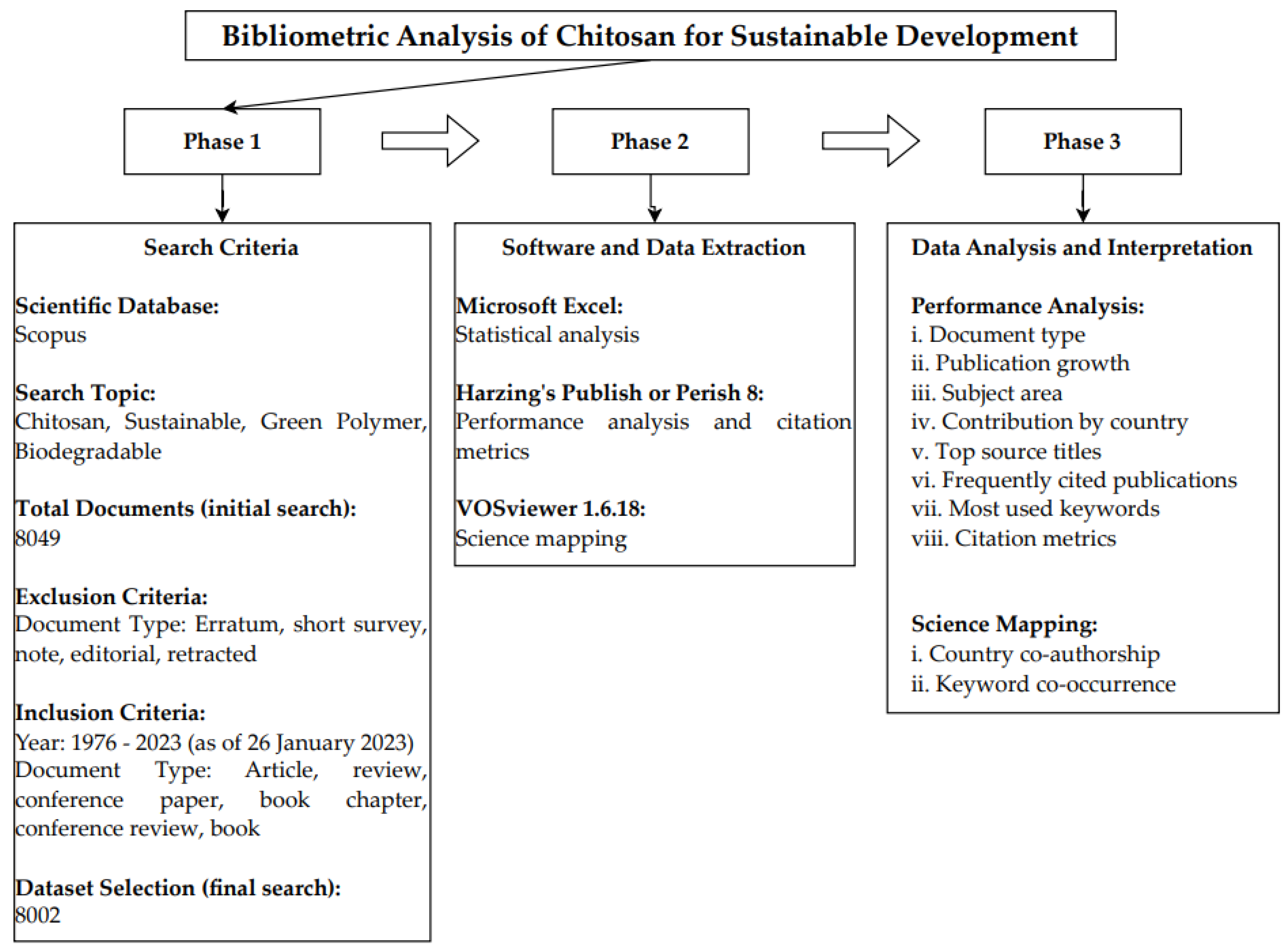
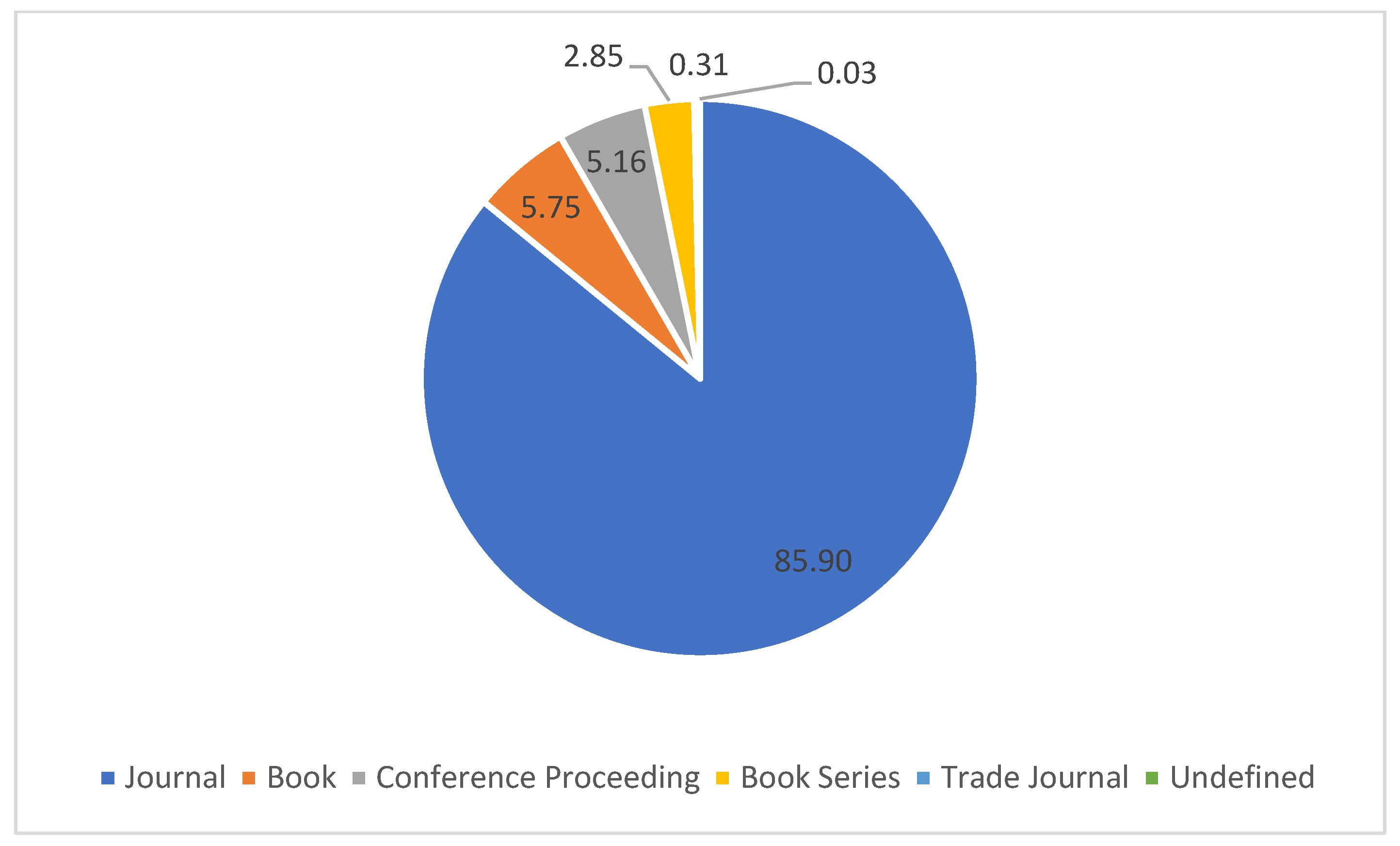
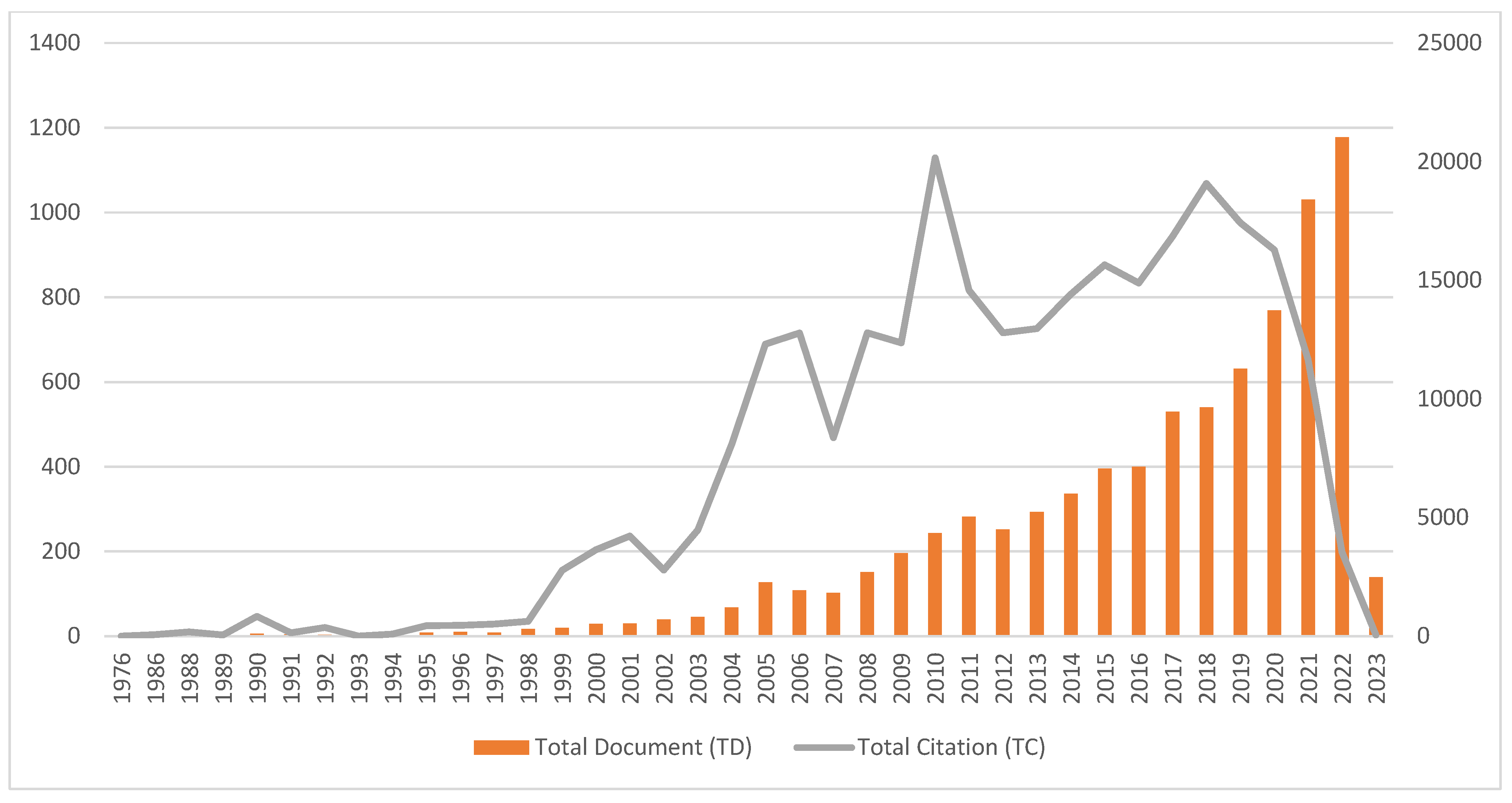
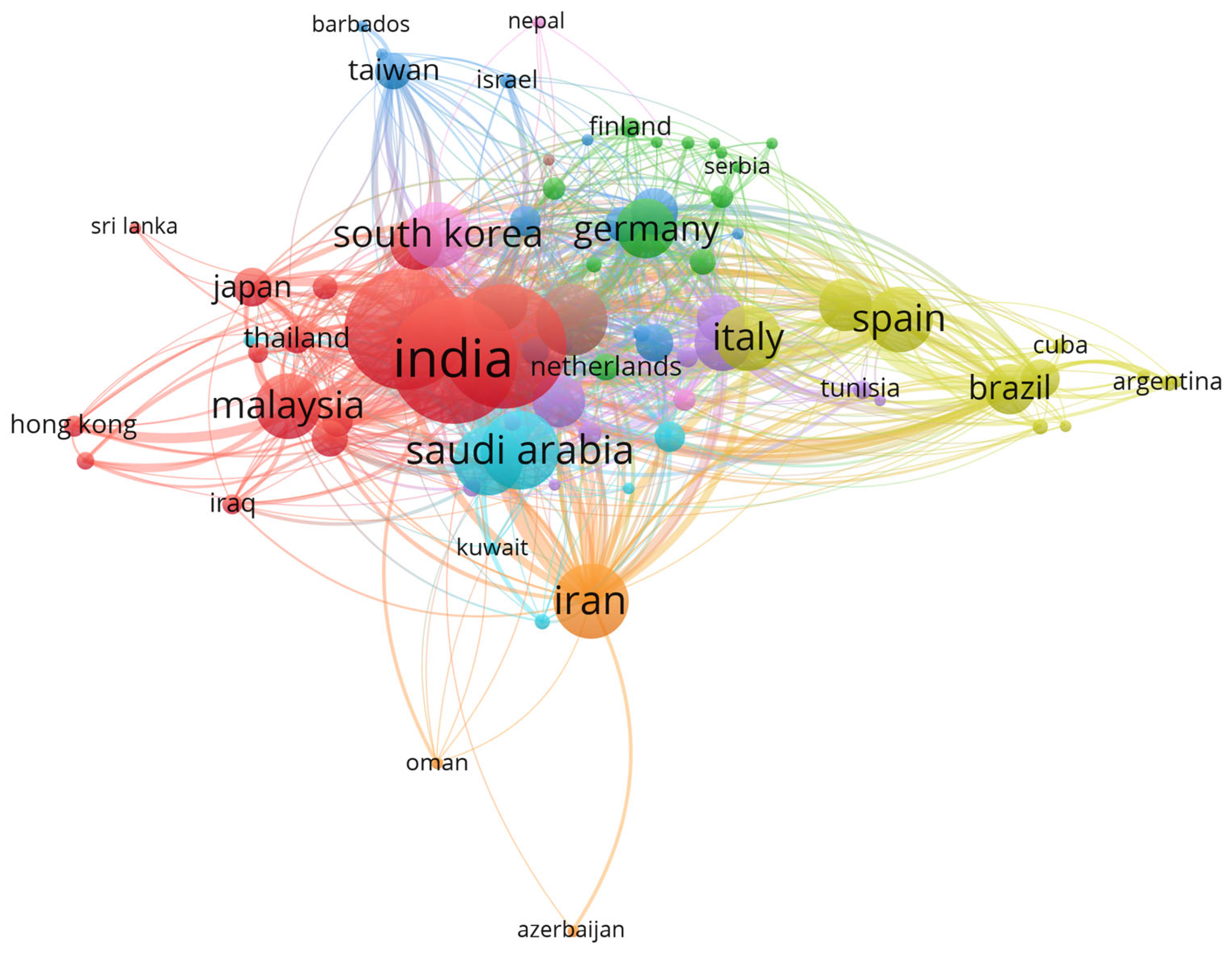
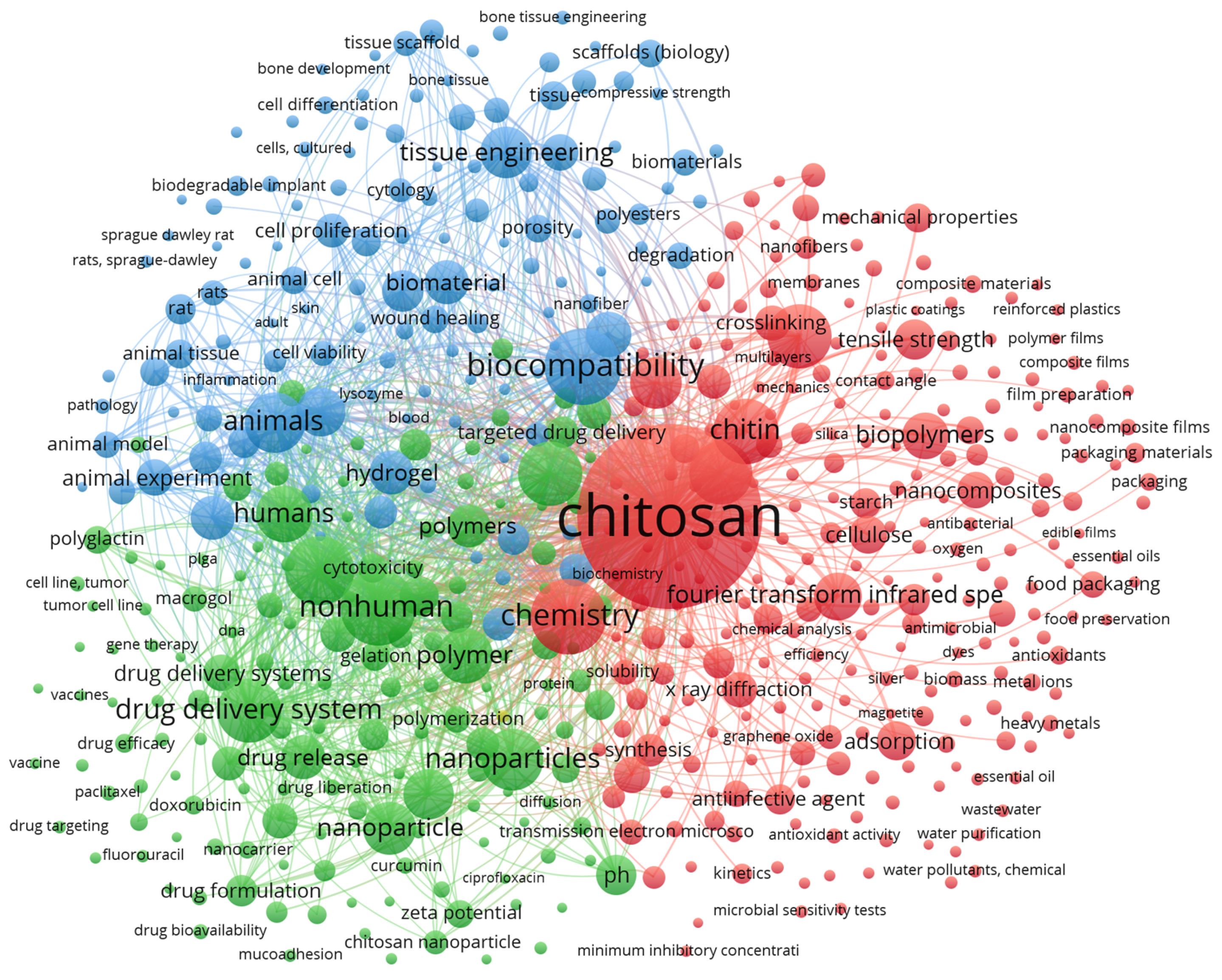
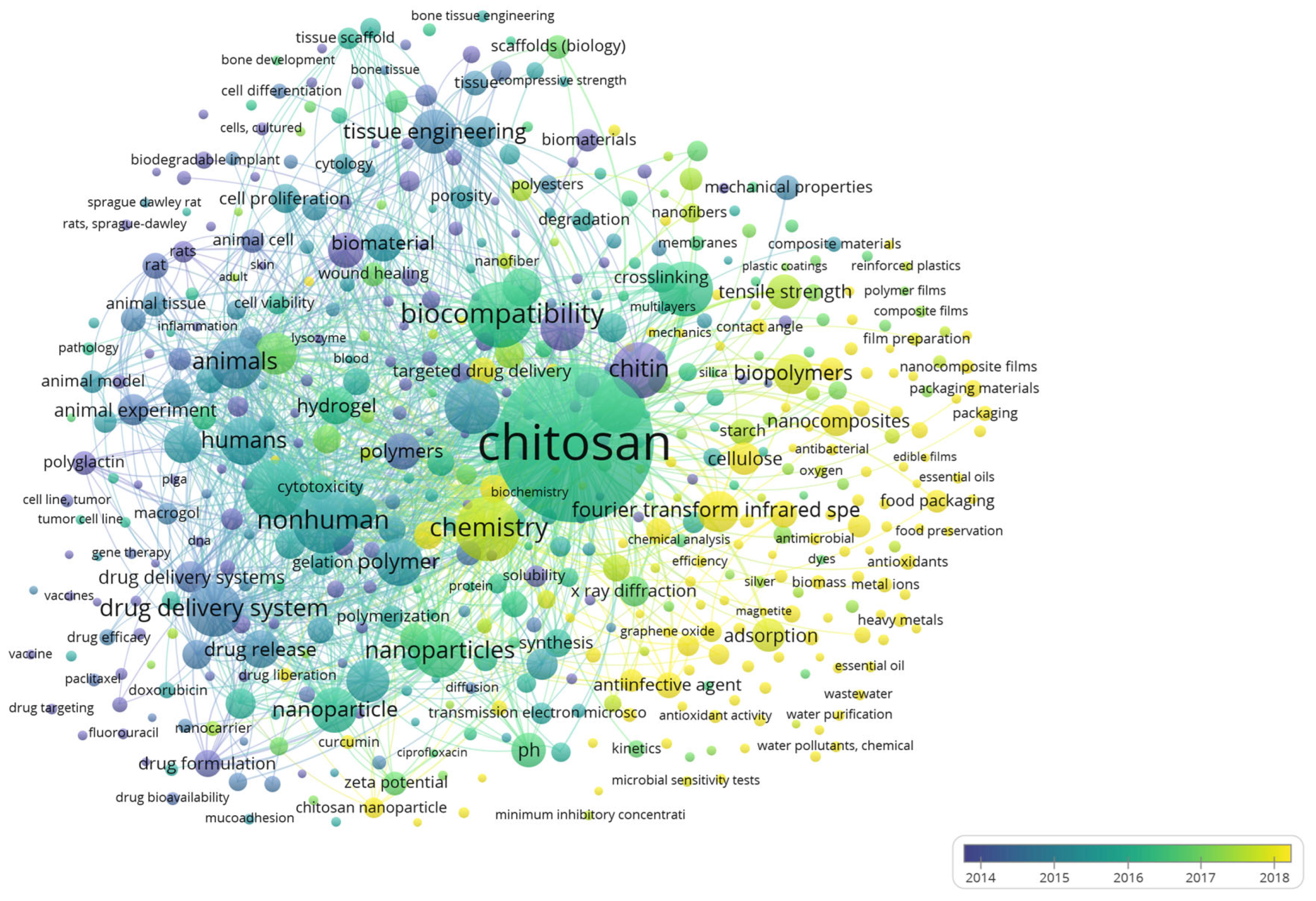
| Document Type | Total Documents | Percentage (%) |
|---|---|---|
| Article | 5736 | 71.68 |
| Review | 1107 | 13.83 |
| Conference Paper | 560 | 7.00 |
| Book Chapter | 509 | 6.36 |
| Conference Review | 67 | 0.84 |
| Book | 23 | 0.29 |
| Total | 8002 | 100 |
| Year | TD 1 | Percentage (%) | Cumulative Percentage (%) | NCD 2 | TC 3 | C/D 4 | C/CD 5 | h-Index | g-Index |
|---|---|---|---|---|---|---|---|---|---|
| 1976 | 1 | 0.01 | 0.01 | 1 | 2 | 2 | 2 | 1 | 1 |
| 1986 | 2 | 0.02 | 0.04 | 2 | 60 | 30 | 30 | 2 | 2 |
| 1988 | 1 | 0.01 | 0.05 | 1 | 175 | 175 | 175 | 1 | 1 |
| 1989 | 2 | 0.02 | 0.07 | 2 | 48 | 24 | 24 | 2 | 2 |
| 1990 | 6 | 0.07 | 0.15 | 5 | 830 | 138.33 | 166 | 3 | 6 |
| 1991 | 4 | 0.05 | 0.20 | 4 | 142 | 35.5 | 35.5 | 4 | 4 |
| 1992 | 3 | 0.04 | 0.24 | 3 | 363 | 121 | 121 | 3 | 3 |
| 1993 | 2 | 0.02 | 0.26 | 0 | 0 | 0 | 0 | 0 | 0 |
| 1994 | 3 | 0.04 | 0.30 | 3 | 90 | 30 | 30 | 3 | 3 |
| 1995 | 8 | 0.10 | 0.40 | 5 | 439 | 54.88 | 87.8 | 5 | 8 |
| 1996 | 10 | 0.12 | 0.52 | 9 | 451 | 45.1 | 50.11 | 7 | 10 |
| 1997 | 8 | 0.10 | 0.62 | 8 | 509 | 63.63 | 63.63 | 5 | 8 |
| 1998 | 17 | 0.21 | 0.84 | 16 | 620 | 36.47 | 38.75 | 9 | 17 |
| 1999 | 20 | 0.25 | 1.09 | 18 | 2774 | 138.7 | 154.11 | 14 | 20 |
| 2000 | 29 | 0.36 | 1.45 | 28 | 3642 | 125.59 | 130.07 | 21 | 29 |
| 2001 | 30 | 0.37 | 1.82 | 29 | 4219 | 140.63 | 145.48 | 24 | 30 |
| 2002 | 39 | 0.49 | 2.31 | 36 | 2787 | 71.46 | 77.42 | 24 | 39 |
| 2003 | 45 | 0.56 | 2.87 | 44 | 4469 | 99.31 | 101.57 | 24 | 45 |
| 2004 | 68 | 0.85 | 3.72 | 62 | 8086 | 118.91 | 130.42 | 38 | 68 |
| 2005 | 127 | 1.59 | 5.31 | 109 | 12,313 | 96.95 | 112.96 | 52 | 110 |
| 2006 | 108 | 1.35 | 6.66 | 96 | 12,771 | 118.25 | 133.03 | 47 | 108 |
| 2007 | 102 | 1.27 | 7.94 | 95 | 8362 | 81.98 | 88.02 | 45 | 91 |
| 2008 | 151 | 1.89 | 9.82 | 137 | 12,787 | 84.68 | 93.34 | 53 | 112 |
| 2009 | 196 | 2.45 | 12.27 | 182 | 12,359 | 63.06 | 67.91 | 60 | 107 |
| 2010 | 243 | 3.04 | 15.31 | 229 | 20,161 | 82.97 | 88.04 | 62 | 139 |
| 2011 | 282 | 3.52 | 18.83 | 256 | 14,576 | 51.69 | 56.94 | 67 | 113 |
| 2012 | 252 | 3.15 | 21.98 | 227 | 12,785 | 50.73 | 56.32 | 59 | 106 |
| 2013 | 293 | 3.66 | 25.64 | 262 | 12,965 | 44.25 | 49.48 | 61 | 105 |
| 2014 | 336 | 4.20 | 29.84 | 301 | 14,408 | 42.88 | 47.87 | 60 | 107 |
| 2015 | 396 | 4.95 | 34.79 | 363 | 15,649 | 39.52 | 43.11 | 64 | 109 |
| 2016 | 400 | 5.00 | 39.79 | 368 | 14,882 | 37.21 | 40.44 | 62 | 104 |
| 2017 | 530 | 6.62 | 46.41 | 458 | 16,842 | 31.78 | 36.77 | 63 | 107 |
| 2018 | 540 | 6.75 | 53.16 | 508 | 19,074 | 35.32 | 37.55 | 66 | 110 |
| 2019 | 631 | 7.89 | 61.05 | 591 | 17,423 | 27.61 | 29.48 | 63 | 96 |
| 2020 | 769 | 9.61 | 70.66 | 709 | 16,277 | 21.17 | 22.96 | 59 | 86 |
| 2021 | 1031 | 12.88 | 83.54 | 887 | 11,654 | 11.3 | 13.14 | 43 | 61 |
| 2022 | 1178 | 14.72 | 98.26 | 725 | 3541 | 3.01 | 4.88 | 22 | 31 |
| 2023 | 139 | 1.74 | 100.00 | 20 | 43 | 0.31 | 2.15 | 3 | 5 |
| Total | 8002 | 100 | 278,578 |
| Subject Area | Total Document | Percentage (%) |
|---|---|---|
| Materials Science | 3249 | 18.56 |
| Chemistry | 2531 | 14.46 |
| Engineering | 2010 | 11.49 |
| Chemical Engineering | 1865 | 10.66 |
| Biochemistry, Genetics, and Molecular Biology | 1782 | 10.18 |
| Pharmacology, Toxicology, and Pharmaceutics | 1108 | 6.33 |
| Environmental Science | 915 | 5.23 |
| Physics and Astronomy | 821 | 4.69 |
| Agricultural and Biological Sciences | 786 | 4.49 |
| Medicine | 716 | 4.09 |
| Energy | 540 | 3.09 |
| Economics, Econometrics, and Finance | 276 | 1.58 |
| Immunology and Microbiology | 234 | 1.34 |
| Computer Science | 131 | 0.75 |
| Business, Management, and Accounting | 100 | 0.57 |
| Multidisciplinary | 91 | 0.52 |
| Earth and Planetary Sciences | 90 | 0.51 |
| Social Sciences | 56 | 0.32 |
| Health Professions | 49 | 0.28 |
| Veterinary | 34 | 0.19 |
| Mathematics | 32 | 0.18 |
| Neuroscience | 30 | 0.17 |
| Dentistry | 21 | 0.12 |
| Nursing | 20 | 0.11 |
| Arts and Humanities | 7 | 0.04 |
| Psychology | 4 | 0.02 |
| Decision Sciences | 3 | 0.02 |
| Total | 17,501 | 100 |
| Country | TD 1 | NCD 2 | TC 3 | C/D 4 | C/CD 5 | h-Index | g-Index |
|---|---|---|---|---|---|---|---|
| China | 1560 | 1354 | 50,477 | 32.36 | 37.28 | 100 | 163 |
| India | 1400 | 1197 | 48,529 | 34.66 | 40.54 | 101 | 183 |
| United States | 800 | 709 | 55,019 | 68.77 | 77.6 | 110 | 211 |
| Iran | 470 | 402 | 13,940 | 29.66 | 34.68 | 60 | 98 |
| Brazil | 347 | 307 | 8471 | 24.41 | 27.59 | 48 | 78 |
| Italy | 311 | 277 | 10,406 | 33.46 | 37.57 | 51 | 92 |
| South Korea | 305 | 267 | 10,931 | 35.84 | 40.94 | 49 | 95 |
| Egypt | 300 | 256 | 8301 | 27.67 | 32.43 | 46 | 83 |
| Spain | 269 | 242 | 11,411 | 42.42 | 47.15 | 49 | 100 |
| Malaysia | 251 | 212 | 5487 | 21.77 | 25.88 | 39 | 66 |
| Country | Total Document | Total Link Strength |
|---|---|---|
| India | 1400 | 572 |
| United States | 800 | 557 |
| China | 1560 | 527 |
| Saudi Arabia | 164 | 263 |
| Iran | 470 | 248 |
| United Kingdom | 204 | 228 |
| Egypt | 300 | 220 |
| Italy | 311 | 201 |
| Malaysia | 251 | 201 |
| South Korea | 305 | 200 |
| Source Title | TD 1 | Percentage (%) | TC 2 | Publisher | Cite Score | SJR 3 | SNIP 4 | h-Index | JIF 5 | JCI 6 |
|---|---|---|---|---|---|---|---|---|---|---|
| International Journal of Biological Macromolecules | 361 | 4.51 | 16,073 | Elsevier | 11.6 | 1.100 | 1.449 | 144 | 8.025 | 1.42 |
| Carbohydrate Polymers | 271 | 3.39 | 14,519 | Elsevier | 16.0 | 1.612 | 1.821 | 228 | 10.723 | 2.19 |
| Polymers | 135 | 1.69 | 2286 | Multidisciplinary Digital Publishing Institute (MDPI) | 5.7 | 0.726 | 1.170 | 89 | 4.967 | 0.88 |
| Journal Of Applied Polymer Science | 128 | 1.60 | 2968 | Wiley-Blackwell | 5.0 | 0.528 | 0.793 | 175 | 3.057 | 0.61 |
| Materials Science and Engineering C | 74 | 0.92 | 4613 | Elsevier | 12.6 | 1.191 | 1.417 | 145 | NIL 7 | NIL 7 |
| Journal Of Polymers and The Environment | 70 | 0.87 | 1411 | Springer Nature | 6.8 | 0.648 | 1.038 | 80 | 4.705 | 0.65 |
| Biomaterials | 69 | 0.86 | 17,999 | Elsevier | 21.5 | 2.678 | 2.045 | 397 | 15.304 | 2.68 |
| IOP Conference Series: Materials Science and Engineering | 69 | 0.86 | 138 | IOP Publishing Ltd. | 1.1 | 0.249 | 0.344 | 48 | NIL 7 | NIL 7 |
| ACS Sustainable Chemistry and Engineering | 68 | 0.85 | 2513 | American Chemical Society | 14.5 | 1.743 | 1.361 | 132 | 9.224 | 1.44 |
| Molecules | 65 | 0.81 | 1822 | Multidisciplinary Digital Publishing Institute (MDPI) | 5.9 | 0.705 | 1.267 | 171 | 4.927 | 0.64 |
| Author | Title | Year | Cites | Cites Per Year | Source Title |
|---|---|---|---|---|---|
| G. Crini [42] | Non-conventional low-cost adsorbents for dye removal: A review | 2006 | 3590 | 211.18 | Bioresource Technology |
| A. Kumari, S.K. Yadav, S.C. Yadav [66] | Biodegradable polymeric nanoparticles based drug delivery systems | 2010 | 2789 | 214.54 | Colloids and Surfaces B: Biointerfaces |
| J.S. Boateng, K.H. Matthews, H.N.E. Stevens, G.M. Eccleston [43] | Wound healing dressings and drug delivery systems: A review | 2008 | 1945 | 129.67 | Journal of Pharmaceutical Sciences |
| N. Bhattarai, J. Gunn, M. Zhang [67] | Chitosan-based hydrogels for controlled, localized drug delivery | 2010 | 1796 | 138.15 | Advanced Drug Delivery Reviews |
| E. Khor, L.Y. Lim [74] | Implantable applications of chitin and chitosan | 2003 | 1468 | 73.4 | Biomaterials |
| S.V. Madihally, H.W.T. Matthew [75] | Porous chitosan scaffolds for tissue engineering | 1999 | 1338 | 55.75 | Biomaterials |
| A. Chenite, C. Chaput, D. Wang, C. Combes, M.D. Buschmann, C.D. Hoemann, J.C. Leroux, B.L. Atkinson, F. Binette, A. Selmani [76] | Novel injectable neutral solutions of chitosan form biodegradable gels in situ | 2000 | 1199 | 52.13 | Biomaterials |
| A. des Rieux, V. Fievez, M. Garinot, Y.-J. Schneider, V. Préat [77] | Nanoparticles as potential oral delivery systems of proteins and vaccines: A mechanistic approach | 2006 | 1068 | 62.82 | Journal of Controlled Release |
| Y. Li, J. Rodrigues, H. Tomás [78] | Injectable and biodegradable hydrogels: Gelation, biodegradation and biomedical applications | 2012 | 1037 | 94.27 | Chemical Society Reviews |
| L. Klouda [79] | Thermoresponsive hydrogels in biomedical applications | 2008 | 989 | 65.93 | European Journal of Pharmaceutics and Biopharmaceutics |
| Keywords | TD 1 | Total Link Strength |
|---|---|---|
| Chitosan | 6201 | 93,328 |
| Nonhuman | 1492 | 38,976 |
| Chemistry | 1468 | 37,602 |
| Human | 1287 | 34,247 |
| Biocompatibility | 1525 | 31,074 |
| Drug delivery system | 1143 | 28,912 |
| Animals | 1051 | 28,575 |
| Humans | 944 | 26,310 |
| Biodegradability | 1122 | 23,721 |
| Scanning electron microscopy | 1103 | 23,341 |
| Nanoparticles | 1060 | 21,317 |
| Polymer | 900 | 21,023 |
| Animal | 750 | 20,874 |
| Nanoparticle | 820 | 20,062 |
| Particle size | 767 | 19,536 |
| Tissue Engineering | 795 | 19,081 |
| In vitro study | 620 | 18,166 |
| Chitin | 1163 | 17,624 |
| Biodegradable polymers | 1146 | 17,262 |
| Biomaterial | 611 | 16,379 |
| Items | Metrics |
|---|---|
| Date of Extraction | 26 January 2023 |
| Papers | 8002 |
| Citations | 278,578 |
| Years | 47 |
| Citation per Year | 5927.19 |
| Citation per Document | 34.81 |
| Citation per Author | 80,267.14 |
| Papers per Author | 2135.23 |
| Authors per Paper | 4.86 |
| h-index | 215 |
| g-index | 343 |
Disclaimer/Publisher’s Note: The statements, opinions and data contained in all publications are solely those of the individual author(s) and contributor(s) and not of MDPI and/or the editor(s). MDPI and/or the editor(s) disclaim responsibility for any injury to people or property resulting from any ideas, methods, instructions or products referred to in the content. |
© 2023 by the authors. Licensee MDPI, Basel, Switzerland. This article is an open access article distributed under the terms and conditions of the Creative Commons Attribution (CC BY) license (https://creativecommons.org/licenses/by/4.0/).
Share and Cite
Lam, W.S.; Lam, W.H.; Lee, P.F. The Studies on Chitosan for Sustainable Development: A Bibliometric Analysis. Materials 2023, 16, 2857. https://doi.org/10.3390/ma16072857
Lam WS, Lam WH, Lee PF. The Studies on Chitosan for Sustainable Development: A Bibliometric Analysis. Materials. 2023; 16(7):2857. https://doi.org/10.3390/ma16072857
Chicago/Turabian StyleLam, Weng Siew, Weng Hoe Lam, and Pei Fun Lee. 2023. "The Studies on Chitosan for Sustainable Development: A Bibliometric Analysis" Materials 16, no. 7: 2857. https://doi.org/10.3390/ma16072857
APA StyleLam, W. S., Lam, W. H., & Lee, P. F. (2023). The Studies on Chitosan for Sustainable Development: A Bibliometric Analysis. Materials, 16(7), 2857. https://doi.org/10.3390/ma16072857








